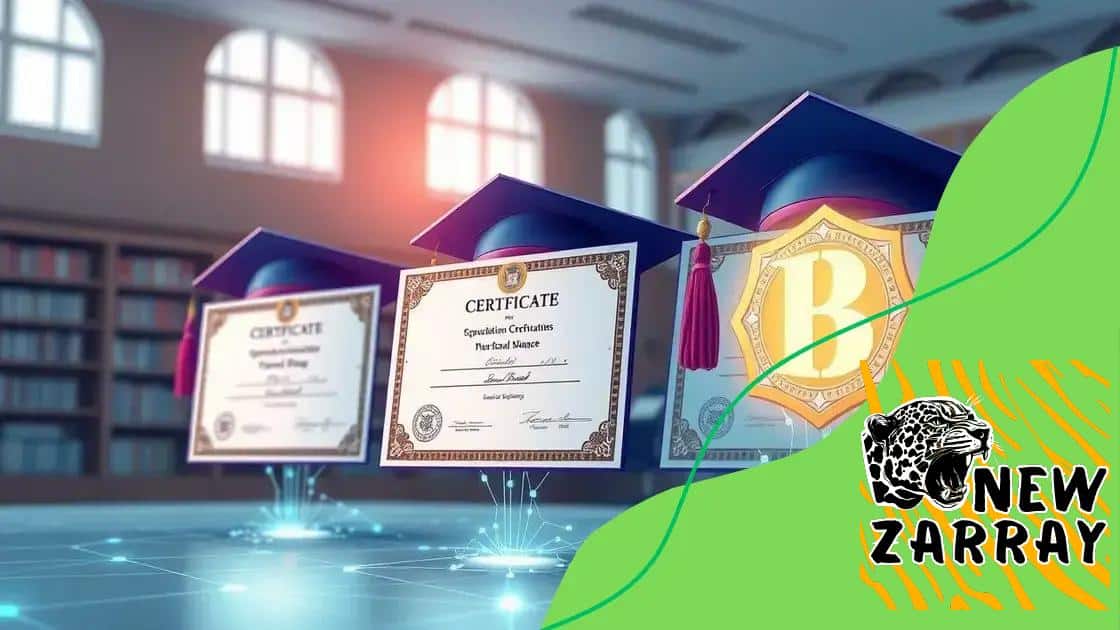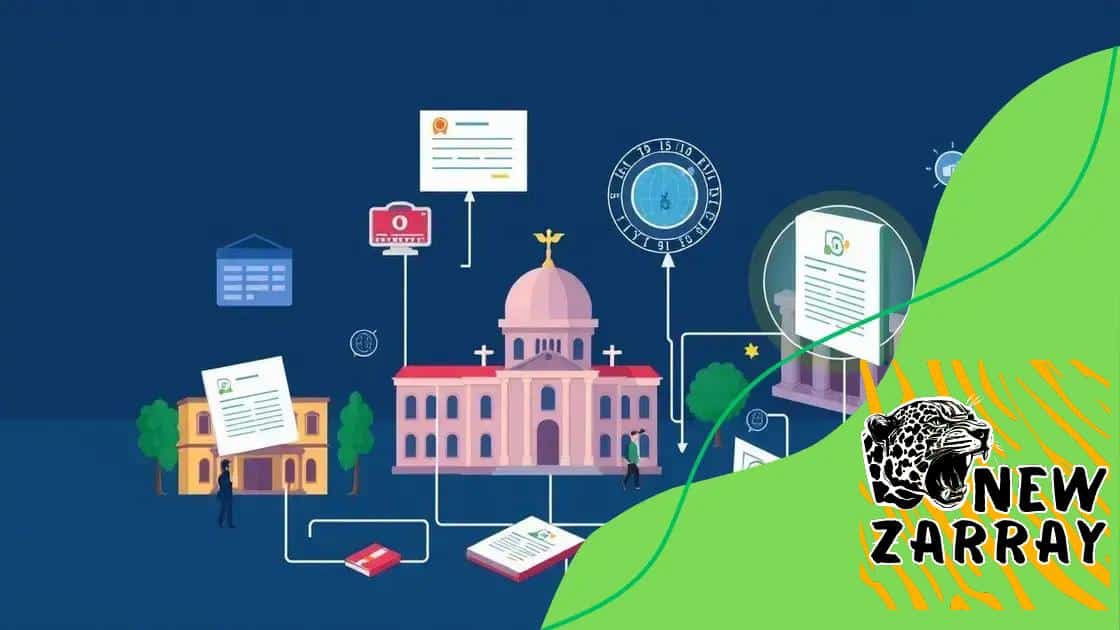Blockchain in higher education credentialing: revolutionizing degrees

Blockchain in higher education credentialing enhances security, enables instant verification of credentials, and supports the integration of micro-credentials, revolutionizing how students showcase their skills and institutions validate achievements.
Blockchain in higher education credentialing is changing the way we think about academic certifications. Imagine a world where your degree is instantly verifiable and secure. This technology could enhance trust and accessibility in education.
Understanding blockchain technology
Understanding blockchain technology is essential for grasping its impact on education. At its core, blockchain is a digital ledger that records transactions securely.
This technology offers a decentralized system, which means that no single entity controls the data. The information is stored across many computers, making it difficult for anyone to alter or hack.
Key Features of Blockchain
There are several key features that make blockchain a game changer:
- Transparency: All transactions are visible to participants.
- Security: Data is encrypted, ensuring only authorized users can access it.
- Immutability: Once recorded, transactions cannot be changed.
- Decentralization: No single point of control or failure.
In education, the use of blockchain can streamline the credentialing process. For instance, a university can securely store diplomas and transcripts, allowing employers to verify these credentials instantly.
By removing intermediaries, blockchain technology not only accelerates the verification process but also reduces costs. Moreover, imagine the potential for students to control their own credentials. With blockchain, they can share their achievements directly without needing a university to act as a middleman.
Applications in Higher Education
Blockchain’s applications in higher education are expanding. Schools can use this technology to enhance operating efficiency and increase trust among stakeholders. For instance, consider how alumni can retain ownership of their records and share them easily with potential employers. This creates a reliable and accessible history of educational achievements.
Furthermore, blockchain can establish new pathways for lifelong learning. As people evolve in their careers, having a verified record of their skills and courses can help them transition into new fields. This flexibility is essential in our rapidly changing job market.
As more institutions adopt blockchain, it becomes clear that this technology has the potential to revolutionize education. Understanding these fundamentals will help stakeholders navigate its benefits and challenges.
Benefits of blockchain for credentialing
There are many benefits of blockchain for credentialing that can change how we validate educational achievements. First, using blockchain technology enhances security. This means that records are less likely to be tampered with, which builds trust among employers and students.
Additionally, blockchain allows for instant verification of credentials. Instead of waiting for confirmation from institutions, employers can immediately access verified records. This speeds up the hiring process and reduces frustration for job seekers.
Key Advantages of Blockchain in Credentialing
Some key advantages include:
- Reduced fraud: It becomes harder to fake degrees or certifications when using blockchain.
- Accessibility: Students can easily share their academic records with potential employers directly.
- Cost efficiency: Eliminates the need for third-party verification services, saving time and money.
- Lifetime ownership: Learners can maintain control over their credentials for future opportunities.
Furthermore, the decentralized nature of blockchain ensures that no single authority controls the data. This shift means that credentialing becomes more transparent. Students feel empowered, knowing they have direct access to their accomplishments.
As educational institutions begin to adopt this technology, the landscape of credentialing will shift. The emphasis on secure and verifiable credentials will likely attract more students interested in ensuring their qualifications are recognized. In turn, companies will benefit from hiring well-qualified candidates backed by verified records.
Moreover, with the rise of online and alternative education, blockchain can accommodate diverse learning pathways. This flexibility helps recognize non-traditional achievements alongside conventional degrees.
How institutions are adopting blockchain

Many educational institutions are now adopting blockchain technology to modernize their credentialing processes. This shift reflects a growing recognition of how blockchain can improve efficiency and trust.
For instance, several universities are experimenting with blockchain to issue diplomas directly to graduates. By doing so, they provide a secure way for students to share their credentials with potential employers.
Steps Institutions Are Taking
There are key steps educational institutions are following as they implement blockchain:
- Partnerships: Many are forming collaborations with tech companies specializing in blockchain.
- Pilot programs: Schools create small-scale initiatives to test how blockchain works within their existing systems.
- Training staff: Educators and administrators are receiving training on how to effectively use and integrate this technology.
- Feedback collection: Institutions gather input from students and employers to refine their blockchain solutions.
As schools begin to realize the potential of blockchain, they also look to enhance transparency in the credentialing process. Through blockchain, learners can trust that their records are protected and easily verifiable.
Moreover, universities are not just focused on degrees; they are also considering using blockchain for certificates and short courses. This adaptability allows for a comprehensive view of a student’s achievements.
Additionally, blockchain has the potential to simplify the transfer process between institutions. Students will no longer face lengthy evaluations when moving schools, as their records can be instantly verified through blockchain.
With technology continuously evolving, many believe that this trend will accelerate. Educational institutions are entering a new era of record keeping, ensuring that credentials reflect true achievements.
Challenges in implementing blockchain
While there are many benefits, several challenges in implementing blockchain also exist. Understanding these hurdles is essential for institutions looking to adopt this technology effectively.
One significant challenge is the need for technical expertise. Many educational institutions lack staff who fully understand how blockchain works. This gap can slow down the implementation process.
Common Obstacles Faced
Some common obstacles include:
- Regulatory concerns: Schools must navigate various legal issues related to data privacy and security.
- Integration with existing systems: Many institutions struggle to mesh blockchain with their current technologies and processes.
- Cost of implementation: Setting up a blockchain system can be expensive, especially for smaller institutions.
- Resistance to change: Some stakeholders may be hesitant to adopt new technology, preferring traditional methods.
Additionally, the pace of technological change can be overwhelming. Blockchain is evolving rapidly, and keeping up with updates and new applications can be challenging for institutions.
Another factor is the need for collaboration among various stakeholders. Effective blockchain solutions require cooperation between institutions, employers, and technology providers. Building these partnerships takes time and effort.
Moreover, security is a double-edged sword. While blockchain is generally secure, any new technology can have vulnerabilities. Addressing potential security risks is crucial to maintaining stakeholder trust.
In conclusion, tackling these challenges will be vital for educational institutions. Overcoming them means not only better credentialing processes but also a more informed and adaptable learning environment for students.
Future trends in education credentialing
Future trends in education credentialing are shaping a new landscape for both institutions and students. As technology evolves, the methods by which students prove their qualifications are also changing.
One significant trend is the increasing integration of micro-credentials. These smaller certificates focus on specific skills or competencies rather than traditional degrees. As a result, learners can showcase their abilities in a more targeted way.
Emerging Innovations
Several innovations are expected to impact credentialing in the near future:
- Blockchain technology: As mentioned earlier, blockchain will likely become the standard for verifying educational records securely.
- AI and machine learning: Educators may use these technologies to personalize learning experiences and automatically assess student achievements.
- Digital portfolios: Students might build online portfolios that display not just degrees but also projects and skills acquired over time.
- Global credential recognition: Efforts are underway to create universal standards for recognizing diplomas and certificates across countries.
Additionally, the demand for flexible learning pathways will rise. More students prefer online and hybrid courses as they balance education with personal and professional commitments. Credentialing methods need to adapt to this shift.
Collaboration between industry and education will influence future trends as well. Employers will play a part in shaping the competencies that educational programs teach. This partnership will ensure that graduates are well-equipped for current job markets.
Finally, a focus on lifelong learning will be vital. As careers evolve rapidly, individuals will need to update their skills continuously. Educational institutions will need to facilitate ongoing credentialing opportunities for their alumni.
FAQ – Frequently Asked Questions about Blockchain in Higher Education Credentialing
What are the main benefits of using blockchain for credentialing?
Blockchain provides enhanced security, immediate verification of credentials, and reduced chances of fraud, making the credentialing process more reliable.
How do micro-credentials work in education?
Micro-credentials are smaller qualifications that focus on specific skills or competencies, allowing students to showcase their abilities more effectively than traditional degrees.
What challenges do institutions face when adopting blockchain technology?
Institutions may encounter challenges such as the need for technical expertise, integration with current systems, regulatory concerns, and resistance to change.
What future trends can we expect in education credentialing?
Future trends include the rise of micro-credentials, digital portfolios, greater industry collaboration, and a focus on lifelong learning to keep skills updated.





